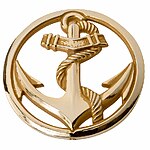
The Croix de Guerre is a military decoration of France. It was first created in 1915 and consists of a square-cross medal on two crossed swords, hanging from a ribbon with various degree pins. The decoration was first awarded during World War I, again in World War II, and in other conflicts; the croix de guerre des théâtres d'opérations extérieures was established in 1921 for these. The Croix de Guerre was also commonly bestowed on foreign military forces allied to France.
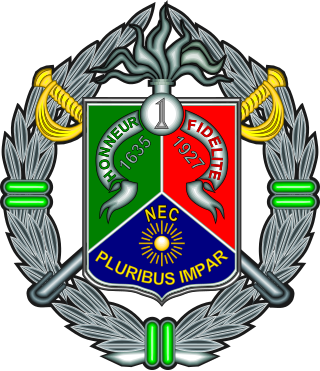
The 1st Foreign Cavalry Regiment is the only cavalry regiment of the Foreign Legion in the French Army. It is one of two armoured cavalry regiments of the 6th Light Armoured Brigade.
The Croix de guerre 1914–1918 is a French military decoration, the first version of the Croix de Guerre. It was created to recognize French and allied soldiers who were cited for valorous service during World War I, similar to the British mentioned in dispatches but with multiple degrees equivalent to other nations' decorations for courage.

The Régiment d'infanterie chars de marine RICM in French, is a light cavalry regiment of the French Army, successor to the Régiment d'infanterie coloniale du Maroc RICM.
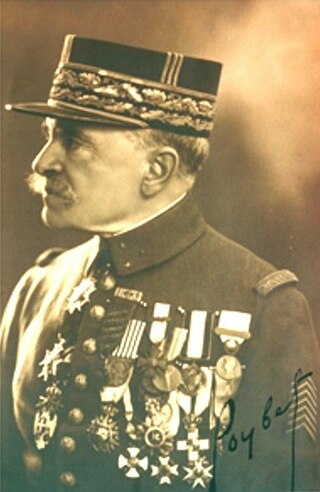
Mariano Francisco Julio Goybet was a French Army general, who held several commands in World War I.

The 1st Marine Infantry Regiment is a French regiment heir of the colonial infantry. The regiment is one of the quatre vieux regiments of the Troupes de Marine, with the 2nd Marine Infantry Regiment 2e RIMa, the 3rd Marine Infantry Regiment 3e RIMa, as well the 4th Marine Infantry Regiment 4e RIMa. Along with the 1st Marine Artillery Regiment 1er RAMa and the 2nd Marine Artillery Regiment 2e RAMa, the 1st Marine formed the Blue Division. The 1er RIMa is a light armoured unit, since 1986, alike with the régiment d'infanterie-chars de marine RICM.
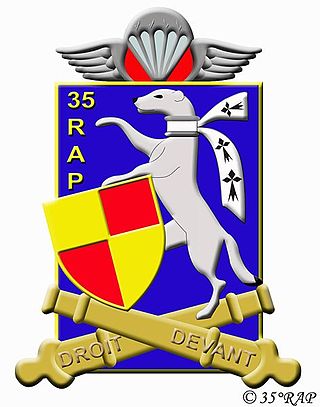
The 35th Parachute Artillery Regiment is the only airborne artillery unit of the French Army forming the air artillery component of the 11th Parachute Brigade. It is based in Tarbes together with the air cavalry, the 1st Parachute Hussar Regiment.

The 2nd Marine Infantry Regiment is an infantry regiment of the Troupes de marine in the French Army, the only regiment to bear 16 battle honours inscriptions of the regimental colors. The regiment is one of the "quatre vieux" regiments of the Troupes de marine, with the 1st Marine Infantry Regiment 1er RIMa, the 3rd Marine Infantry Regiment 3e RIMa and the 4th Marine Infantry Regiment 4e RIMa ; also, alongside the 1st Marine Artillery Regiment 1er RAMa as well as the 2nd Marine Artillery Regiment 2e RAMa which formed the Blue Division.
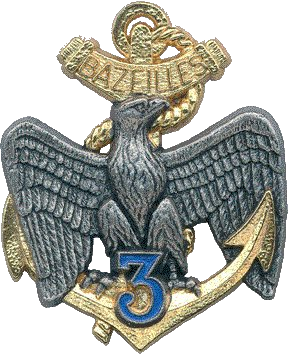
The 3rd Marine Infantry Regiment is a unit of the French Army in the French Forces. The 3e RIMa is one of the oldest of the troupes de marine. This regiment is one of the "Quatre Grands" of marine infantry once garrisoned within the four military ports, ready to embark : the « Grand Un », the « Grand Deux », the « Grand Trois » and the « Grand Quatre ». The « Grand Trois » has participated actively to the various far expeditions of the 19th century in Africa, the Americas, Oceania and the Orient. Surnamed also the "3rd Marine", the unit was part of the « Blue Division » which illustrated capability at the Battle of Bazeilles on August 31 and September 1, 1870. The regiment was subordinated to the 9th Marine Infantry Brigade.

The 11th Marine Artillery Regiment (France) (French: 11e Régiment d'Artillerie de Marine, 11e RAMa) is an artillery regiment of the French Army. The regiment constitutes the fire support unit of the 9th Marine Infantry Brigade. The regiment employs around 950 men, fielding TRF1 155mm howitzers and MO-120-RT-61 120mm mortars. The regiment was founded in a third operational phase in 1951.
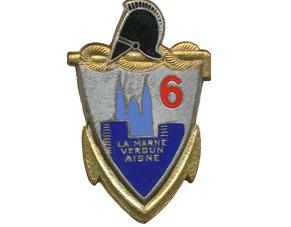
The 6th Engineers Regiment is a regiment of the génie militaire of the French Military constituted under the IIIrd Republic. It is the only Engineers Regiment among the Troupes de Marine.
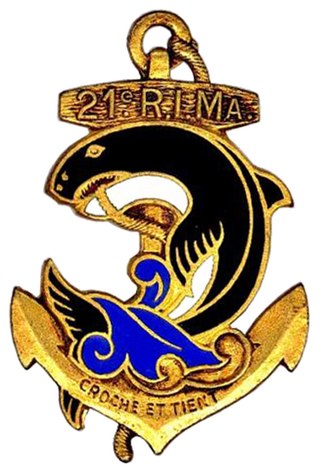
The 21st Marine Infantry Regiment is a unit of the French military issued by filiation from the 2e RIC.

The 3rd Marine Artillery Regiment is the heir to the 3rd Marine Artillery Regiment created in Rochefort by Napoleon Bonaparte's consular decree of May 13, 1803, the 3rd Colonial Artillery Regiment, then the 3rd Marine Artillery Regiment. The 3e RAMa has been present in either a constituted corps or isolated unit since 1803, on almost all the battlefields in which France has been engaged. The regiment was founded in a third operational phase in 1943.

The 6th Field Artillery Regiment is a Field Artillery Branch regiment of the United States Army first activated in 1907 from numbered companies of artillery. It was first organized with two battalions.
The 503e régiment de chars de combat 503e RCC in French, was an armoured tank unit of the French Army created on June 4, 1918 and which took part in the two world wars. The regiment merged with the 501e Régiment de chars de combat 501e RCC to form the 501e-503e Régiment de chars de combat 501e-503e RCC, a unit equipped with 80 Leclerc tanks. The regiment was dissolved on June 23, 2009.
The 501e Régiment de chars de combat 501e RCC in French, is an armoured tank unit of the French Army created on 13 May 1918, and which took part in the two world wars, the Russian Civil War, the Indochina war, and the Algerian war.
The 120th Field Artillery Regiment is a field artillery regiment of the Wisconsin Army National Guard.
The French forces in Djibouti (FFDj) (French: Les forces françaises stationnées à Djibouti, lit. 'The French forces stationed in Djibouti') is a French overseas military base. It constitutes one of the larger French military contingents outside France. The French military has remained present in Djibouti since the territory's independence. Starting June 1977 the conditions of the French forces were set by the framework of a provisional protocol (equivalent to a defense agreement). A new agreement has been in force since 2014.
57th Infantry Division was an infantry division of the French Army during the First World War. It was deployed overseas, seeing action on the Salonika front, fighting alongside British troops. It was sent to the Crimea in December 1918 as part of the Army of the Danube.
17th Colonial Infantry Division was an infantry division of the French Army during the First World War. It was deployed overseas, seeing action during the Gallipoli campaign, and thereafter on the Salonika front, fighting alongside British troops in both theatres of war. It was sent to the Crimea in December 1918 as part of the Army of the Danube.

